Beetles Invasion: One Artist’s Take on the Insect
A swarm of giant beetles, lovingly sculpted by Washington D.C.-based artist Joan Danziger, descends on the American University Museum
/https://tf-cmsv2-smithsonianmag-media.s3.amazonaws.com/filer/20121102100008SummerBeetle-web.jpg)
Perched on a stool in her studio in northwest Washington, D.C., artist Joan Danziger pages through the book Living Jewels. “This one influenced me,” she says, pointing to Phaedimus jagori, a green-and-gold beetle from the Philippines. The book contains flattering portraits of beetles taken by photographer Poul Beckmann. “See this one?” Danziger asks, showing me a yellow-and-black striped beetle from Mexico called Gymnetis stellata. “It became the ‘Tiger Beetle’ up there.”
Clinging to a white wall in front of us are dozens of beetles—sculpted in all different shapes, sizes and colors. “They are real beetles, adapted,” says Danziger. The artist pores over books and other research on the Coleoptera order of insects so that she can apply some of the patterning and anatomy of real beetles to her sculpted ones; yet, the artist also exercises creative freedom. For instance, Danziger hasn’t made any of her beetles actual size. “That would be too realistic. The whole idea, in my mind, is to elongate and exaggerate them and make them beautiful,” she says. Her sculptures range from one to six feet in length.
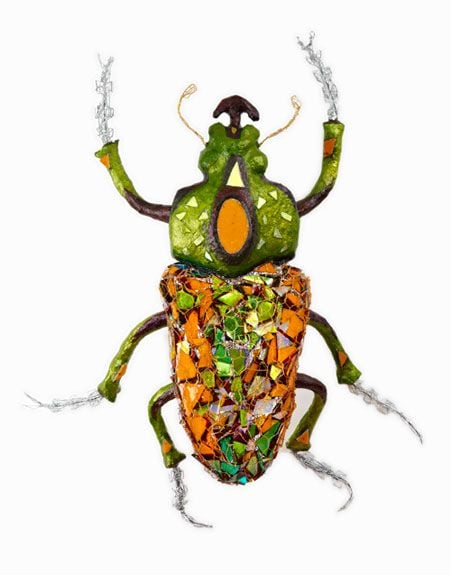
This Saturday, Danziger’s swarm descends on the American University Museum at the Katzen Arts Center in Washington, D.C. All 72 of her giant beetles will be crawling up the gallery’s 50-foot walls in an exhibition titled “Inside the Underworld: Beetle Magic,” on display through December 16, 2012.
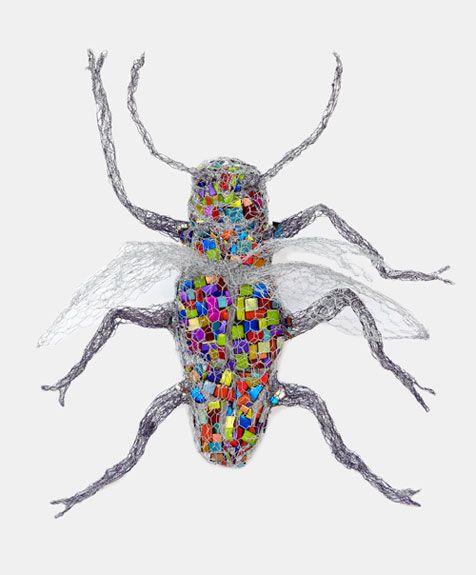
Danziger brings over 40 years of experience as a working artist to this project. She earned a bachelor of fine arts in painting from Cornell University and then went on to study at the Art Students Leagues in New York City and the Academy of Fine Arts in Rome. She also attended artist residencies in Greece and France. Her public art can be seen in D.C., Maryland and New Jersey, and museums, including the National Museum of Women in the Arts, the New Orleans Museum of Art, the Susquehanna Art Museum and the New Jersey State Museum, have acquired her pieces for their permanent collections.
In the late 1960s, Danziger transitioned from painting to sculpture. “I got tired of being confined by the canvas,” she says. Nature and animals figure strongly in her work—a result, she says, of lots of time spent living outdoors, backpacking in the western United States and summering in Idaho. But the artist has a particular fondness for exotic animals not found in those parts—rhinos, giraffes, zebras and parrots—and a definite flair for the whimsical. She has sculpted figures, half human and half animal, performing acrobatics, cycling and playing in bands.
Now, says Danziger, “Everyone wants to know, why beetles?”

Since discovering Beckmann’s book Living Jewels, Danziger has done quite a bit of research on the insects. “There are 350,000 beetles in 160 families,” she reports. “You kind of get addicted.” At first, it was the beetles’ iridescent colors that drew her in. But, now, Danziger is enamored with all the mythology surrounding the bugs.
The scarab beetle (Scarabaeus sacer) symbolized great power and immortality to ancient Egyptians, Danziger says. The beetles are known to roll balls of dung and drop them into burrows in the ground. Female scarabs then lay eggs in the dung. The larvae, believe it or not, eat their way through the dung ball and then emerge from the ground.
“I like beetles, because they are survivors,” says Danziger. “Through all kinds of traumas of life, they are the ones that are going to survive.”
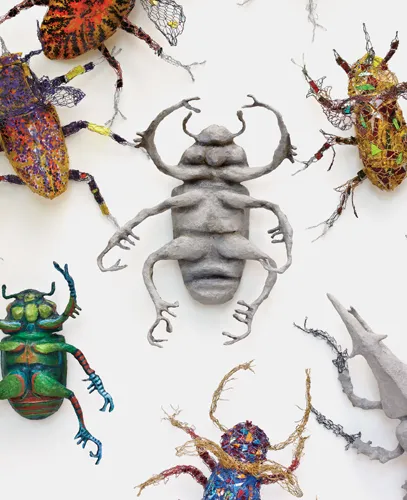
Danziger’s sculptures capture, in a sense, the full life cycle of beetles. Each of her beetles starts with an intricately woven wire armature. “They are kind of born in the wire,” she says, showing me some sculptures made strictly of wire. “Then, they roll out and get covered with ash, which is the gray material that I have up there.” She points to a gray beetle, flipped on its back and hanging on the wall; its wire foundation is completely covered in celluclay, a type of papier-mache. “And then they get reborn into color,” she explains. With this project, Danziger reinvented herself as a fused glass artist. She essentially builds mosaics of cut glass within the beetles’ wire frames. For the insects’ shells, she melts glass decorated with frit, or little pieces of colored glass, in a large kiln; the glass slumps over a mold, which gives the shell its curvature.
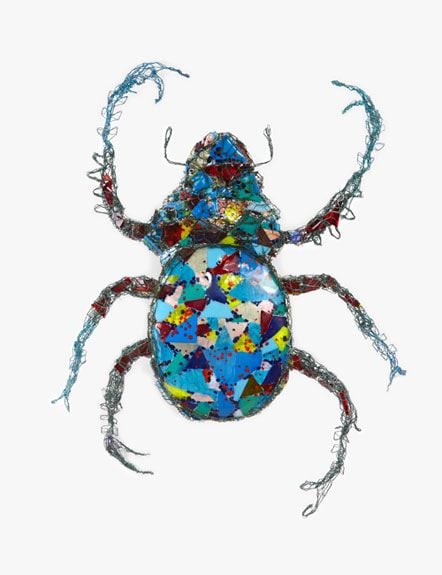
“Metamorphosis is the key,” writes Lenore Miller, director of George Washington University’s Luther W. Brady Art Gallery, in the exhibition catalog, “as these sculptures transform into creatures not found in nature, having evolved out of the artist’s imagination.”
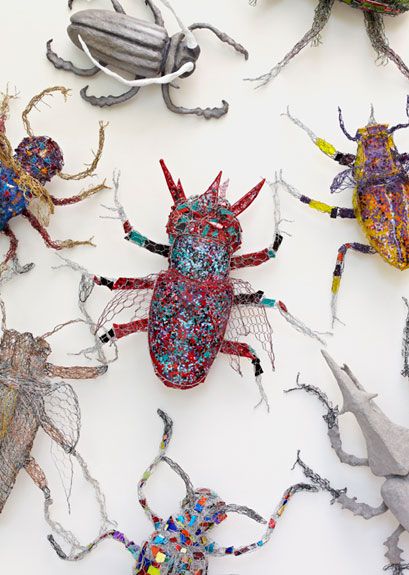
Danziger leads me around her studio to introduce me to her beetle babies. “They all have names,” she says. “That is Spider. That is Retro. This is Copper Wing.” I meander through a herd of monstrous beetles laid out on the floor, taking great care not to step on a leg, antenna or wing. She hunts down a “little fellow” modeled after an actual rhinoceros beetle and an “interesting guy” inspired by a Hercules beetle. A Hercules beetle, Danziger says, can carry more weight for its size than almost any other species. After sharing the tidbit, she carries on. “This is Midnight Beetle. That is Bumblebee. This is Red Devil Beetle,” she adds. Red Devil Beetle has sharp red horns protruding from its head.
“Some people think they are absolutely beautiful, and others think, oh my God, beetles, creepy crawlies,” says Danziger. “I kind of like that dual reaction, between beauty and horror. When people think of beetles, they think of them as tiny things. But here they are magnified. They are beautiful, but strange.”
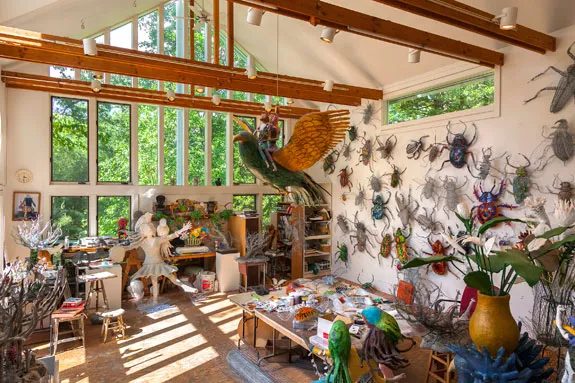
/https://tf-cmsv2-smithsonianmag-media.s3.amazonaws.com/accounts/headshot/megan.png)
/https://tf-cmsv2-smithsonianmag-media.s3.amazonaws.com/accounts/headshot/megan.png)